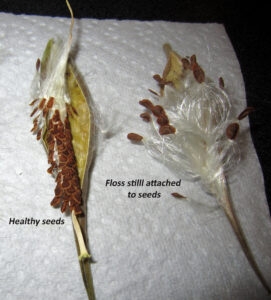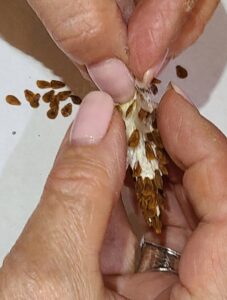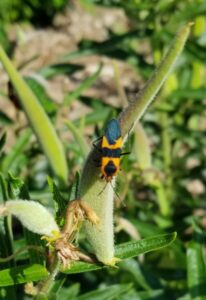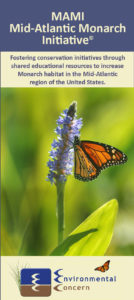Seed Stewards for Monarchs
Our newest MAMI initiative, Seed Stewards for Monarchs, was introduced in 2018. The goal of the program is to increase milkweed seed inventory in order to grow more milkweed. Seed Steward volunteers receive free swamp milkweed (Asclepias incarnata) or butterfly milkweed (Asclepias tuberosa) plants to start a Monarch butterfly habitat. Seed Stewards also receive a welcome bag filled with milkweed tools, tips and tags. Stewards collaborate with each other and with EC by sharing helpful hints by email, social media and in person. As the milkweed pods mature, and the seeds are ready to collect, Seed Steward volunteers exchange their seeds for more milkweed plants grown in EC’s nursery. To join the Seed Stewards for Monarchs program, please contact us.
Click on one of our brochures below to learn more.

Click here to join our Seed Stewards for Monarchs Program
Seed Harvesting Guidelines for Milkweed
Follow the process below for successful milkweed seed collection!
Let’s Get Started:
The photo below shows 8 pods picked from butterfly milkweed plants on the same day (late July). See captions in photo for information about each pod.


Photo 1. Pods in early stage of growth
When the pod is bright green in color, and slim like a string bean, the pods and seeds are forming, but not ready to harvest. If you see milkweed bugs or aphids on your pods, flick them off with your finger, or spray with a hose to wash them off. They will damage the seeds in the pod.

Photo 2. Pods in mid-stage of growth
As the pod grows taller and wider, and changes to a brownish/red color, the seeds are maturing, but they are not ready to harvest. When it is almost ready to burst, press gently on the seam. If the pod opens easily, the seeds should be ready to harvest. Do not force the seam to open.

Photo 3. Not all milkweed pods will produce viable seeds. Ripe pods, like the one above, are dry, gray or even brown. This pod was ready to burst.

Photo 4. When the pods open easily along the seam, and the seeds are a dark brown color, the pod is ready to harvest. If the seeds appear plump and healthy, place the pod(s) in a brown paper bag or on a paper towel to allow the seeds and floss to dry out. This is an important step in the process.

Photo 5. Check the pods for bugs. If the pod is infested with bugs, throw it back outside, away from your garden.



Photos 6, 7, 8. Seed preparation: separating the seed from the floss, and preparing for storage:
After you have collected your pods, bring them to a cool dry place and prepare to separate the seeds from the silk and pod. The most efficient way is to do it by hand.
- Hold the pod in two hands and open it enough to put a thumb over the silk.
- Slowly pry open the pod more so that you can extract the seeds into a container.
You may want to use the “bag method”. Empty the contents of the seed pods into a paper bag and add several pennies. Close the bag and shake. The pennies will help separate the seeds from the floss. After shaking gently, cut a small hole in the corner of the bag and the seeds should start pouring out. Place the seeds in a paper bag or container.

Photo 9. Transfer your dry seed into a permanent container. A small plastic container works, but a basic paper bag, envelopes or even jars are also suitable. Make sure that the containers are dry. Label your container with the species name, and the date and location of the seed collection.
Begin the chilling process….
Put your container in a refrigerator until you donate your seeds to EC, or store for your own use in the spring.
Milkweed seeds in nature undergo a process called stratification where their outer shell is cracked by the cold winter weather, allowing the seed to sprout in spring.
By storing the seed in a refrigerator over the winter, EC is directly mimicking this natural process. By simulating this natural process, the viability of the seeds is greatly increased.
Troubleshooting – Got Bugs?

Milkweed Bugs
Milkweed bugs are large red and black bugs that like to feed on milkweed by eating milkweed seeds and tissue from the plants. Just like aphids, they are not going to hurt the caterpillars. You can flick the milkweed bugs off of the pod with your fingers, and place them in a solution of soapy water. This will kill them. You may also use a solution of dish detergent and water to spray the bugs. You must rinse the plant the next day to remove any soap residue off of the plant, or you will adversely impact the health of caterpillars and monarchs. Check for eggs or caterpillars before you spray the plants!

Aphids
Aphids are tiny yellow/orange colored insects that like to feed on milkweed. While they will not harm the caterpillars, they do eat the milkweed leaves that caterpillars feed on, and they will destroy the seed pods. A seed pod covered with aphids will not produce healthy seed. There are control measures that are successful, but you have to keep after the aphids throughout the season. Once they find your milkweed, they will multiply quickly. You may also use the same solution of dish detergent and water to spray the aphids. Rinse the plant the next day to remove any soap residue. Check for eggs or caterpillars before you spray the plants!
Contact us at sslear@wetland.org if you need assistance harvesting your milkweed seed!
Seed Stewards Map



